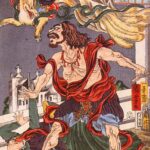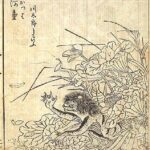Konohanasakuya-hime, often referred to as the “Princess of the Blossoms,” is a prominent figure in Japanese mythology. She is known for her association with cherry blossoms, which symbolize the beauty and transience of life. Her story is intertwined with themes of love, nature, and the cycles of life and death. In this article, we will explore her origins, significance, and various aspects of her mythology, offering insights into her role in the Shinto religion and Japanese culture.
Origins of Konohanasakuya-hime
Konohanasakuya-hime is a daughter of the mountain deity Omoikane and is often depicted as a beautiful young woman. Her name translates to “Princess who makes the trees bloom,” which reflects her deep connection to nature and the changing seasons. According to the legends, she descended from the heavens to the earth, where she brought forth the beauty of flowering trees, particularly the cherry blossoms that bloom in spring. This connection to nature is a vital aspect of her identity and is celebrated in various cultural practices in Japan.
 Kojin
KojinOne of the most well-known tales involving Konohanasakuya-hime is her marriage to the hero Ninigi-no-Mikoto, the grandson of the sun goddess Amaterasu. The story goes that Ninigi descended from the heavens to rule over the earth. Upon his arrival, he encountered Konohanasakuya-hime and was immediately captivated by her beauty. They fell in love and soon married, symbolizing the union between the divine and the earthly. This marriage is significant as it represents the connection between the heavens and the natural world, embodying the harmony that exists within Japanese beliefs.
Symbolism of Cherry Blossoms
Cherry blossoms, or sakura, are not just beautiful flowers; they carry profound meanings in Japanese culture. They are a symbol of transience, representing the fleeting nature of life. The short blooming period of cherry blossoms reminds people to cherish the present moment, as life is ephemeral. This symbolism aligns closely with the essence of Konohanasakuya-hime, as she embodies the beauty and fragility of life through her association with these blossoms.
During the spring season, cherry blossom festivals, known as hanami, are celebrated across Japan. People gather under blooming cherry trees to enjoy picnics and appreciate the beauty of nature. These festivals honor not only the beauty of the blossoms but also the spirit of Konohanasakuya-hime. Her influence is felt deeply during these celebrations, as she is believed to bring forth the blossoms and bless the gatherings with her presence.
 Kitsune
KitsuneMythological Significance
In Japanese mythology, Konohanasakuya-hime is often regarded as a goddess of fertility and agriculture. Her connection to nature extends beyond cherry blossoms; she is also associated with the growth of rice, a staple food in Japan. The rice plant is often seen as a representation of life and sustenance, and her role in its growth highlights her importance in agricultural practices. Many farmers pray to her for a bountiful harvest, recognizing her as a protector of crops.
Moreover, Konohanasakuya-hime is also linked to the concept of birth and motherhood. Her role as a goddess of fertility is celebrated in various rituals aimed at ensuring safe childbirth and healthy children. In many households, she is honored during pregnancy, with prayers offered for the well-being of both the mother and the child. This aspect of her mythology showcases the deep respect for femininity and motherhood within Japanese culture.
Legends and Tales
Several legends surround Konohanasakuya-hime, each highlighting different facets of her character. One of the most famous stories is that of her husband, Ninigi, and their three children. After their marriage, Konohanasakuya-hime gave birth to three sons. However, there is a twist to this tale: when Ninigi questioned the legitimacy of their births, Konohanasakuya-hime, in a fit of anger, set fire to the house they lived in to prove that her children were indeed hers. This act of burning the house symbolizes her fierce protection of her family and her determination to uphold her honor.
 Kawaya-no-kami
Kawaya-no-kamiAnother significant tale involves the challenges she faced after her marriage. Despite being a divine being, Konohanasakuya-hime experienced struggles that resonate with the human experience. Her stories often reflect the themes of resilience and the trials of motherhood, illustrating that even deities have their share of hardships. This relatability is part of what makes her a beloved figure in Japanese mythology, as she embodies both strength and vulnerability.
Cultural Impact
Konohanasakuya-hime’s influence extends beyond mythology into various aspects of Japanese culture. She is often depicted in traditional art, literature, and festivals, where her image serves as a reminder of the beauty of nature and the importance of harmony in life. Many artists have captured her essence through paintings and sculptures, portraying her surrounded by cherry blossoms, emphasizing her connection to nature.
In addition to visual art, Konohanasakuya-hime is also a popular subject in Japanese literature. Her stories are woven into folk tales and poems, reflecting the deep appreciation for her character and the themes she represents. The literary works that feature her often explore the duality of life, love, and the transient nature of existence, resonating with readers across generations.
Festivals and Celebrations
Throughout Japan, various festivals celebrate Konohanasakuya-hime and her connection to cherry blossoms. One of the most notable is the Hanami Festival, where people gather to view the cherry blossoms in full bloom. This celebration typically occurs in early spring and marks the beginning of the cherry blossom season. During this time, families and friends come together for picnics under the trees, sharing food and enjoying each other’s company while appreciating the fleeting beauty of the blossoms.
- Hanami: A traditional celebration of cherry blossoms.
- Shinto Rituals: Prayers offered for a good harvest and fertility.
- Art Exhibitions: Showcasing artwork inspired by Konohanasakuya-hime.
These festivals are not only a celebration of nature but also a tribute to Konohanasakuya-hime herself. They serve as a reminder of her role in bringing beauty to the world and the importance of appreciating the present moment. Additionally, during these celebrations, rituals are performed to honor her, asking for blessings of fertility and good fortune in the coming year.
Modern Interpretations
In contemporary Japan, Konohanasakuya-hime continues to inspire various forms of expression, including fashion, music, and even modern storytelling. Many designers draw inspiration from her image, incorporating floral motifs and elegant designs that reflect the beauty of cherry blossoms. This connection to nature resonates with the current trend of sustainability and appreciation for the environment.
Moreover, Konohanasakuya-hime’s story is sometimes retold in modern media, including anime and manga. These adaptations often highlight her strength, resilience, and the challenges she faces, appealing to younger audiences. By incorporating traditional elements into contemporary storytelling, her legacy continues to thrive, ensuring that her significance is not lost in modern society.
Konohanasakuya-hime is a multifaceted figure in Japanese mythology whose influence permeates various aspects of culture and tradition. Her connection to cherry blossoms symbolizes the beauty and transience of life, while her role as a goddess of fertility and agriculture highlights her importance in sustaining life. Through festivals, art, and modern interpretations, her legacy continues to inspire and resonate with people, reminding us of the beauty that exists in nature and the importance of cherishing every moment.
